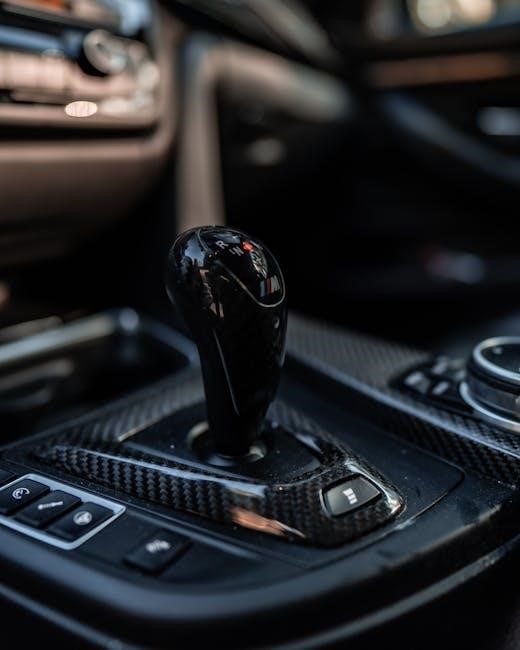The BMW 335i manual transmission offers a smooth‚ precise shifting experience‚ combining sporty driving dynamics with everyday usability. Its 6-speed design ensures optimal gear ratios for both performance and efficiency‚ making it a favorite among driving enthusiasts seeking a more engaging connection to the road.
Overview of the BMW 335i and Its Transmission Options
The BMW 335i is a high-performance variant of the 3 Series‚ offering a blend of power and precision. It features a 3.0-liter inline-6 engine‚ producing significant horsepower and torque. Transmission options include a 6-speed manual and an 8-speed automatic‚ with the manual being a favorite among driving enthusiasts for its tactile feedback and control. The automatic‚ while convenient‚ includes sport and manual modes for those seeking a more dynamic experience. Both transmissions are designed to complement the car’s rear-wheel-drive layout‚ delivering a balance of performance and comfort. The manual transmission‚ in particular‚ is praised for its smooth‚ precise shifting and engagement‚ making it a standout choice for purists.
Why the Manual Transmission is Popular Among Enthusiasts

The manual transmission in the BMW 335i is highly regarded by driving enthusiasts due to its precise and smooth shifting mechanism. It offers a more direct connection between the driver and the vehicle‚ enhancing the overall driving experience. The ability to control gear changes manually allows for better acceleration and responsiveness‚ particularly during spirited driving. Additionally‚ the manual transmission is lighter and more fuel-efficient compared to its automatic counterpart‚ which appeals to purists seeking a more authentic and engaging drive. Its compact design and innovative low-friction technology further contribute to its popularity‚ making it a preferred choice for those who value driving dynamics and mechanical interaction.
History and Development of the 335i Manual Transmission
The BMW 335i manual transmission traces its roots to the 3 Series lineage‚ refined over generations for precision and smoothness. Its 6-speed design debuted in the E90/E92 models‚ quickly becoming a benchmark for sporty transmissions.
The Evolution of Manual Transmissions in BMW 3 Series
The BMW 3 Series has witnessed significant advancements in manual transmissions‚ with the 335i benefiting from decades of refinement. Early models featured 5-speed units‚ while later iterations introduced 6-speed designs with improved gearing and reduced friction. These enhancements optimized acceleration and fuel efficiency‚ aligning with BMW’s commitment to driving excellence. The introduction of lightweight components and precise engineering in the 335i’s manual transmission further solidified its reputation as a driver-focused system‚ offering a perfect blend of performance and usability for enthusiasts.
Key Features of the 6-Speed Manual Transmission in the 335i
The 6-speed manual transmission in the BMW 335i is renowned for its smooth‚ precise shifting and optimal gear ratios. Designed by ZF Friedrichshafen AG (model S6-53)‚ it is lightweight and compact‚ ensuring excellent drivability and efficiency. The transmission is rated to handle up to 443 lb-ft of torque‚ making it well-suited for the 335i’s powerful engine. Its longitudinal design integrates seamlessly with rear-wheel drive‚ providing a sporty and engaging driving experience. The manual gearbox also features a low-friction design‚ enhancing fuel efficiency without compromising performance. Owners praise its intuitive clutch action and responsive pedal feel‚ solidifying its reputation as a driver-focused transmission that balances everyday usability with thrilling dynamics.
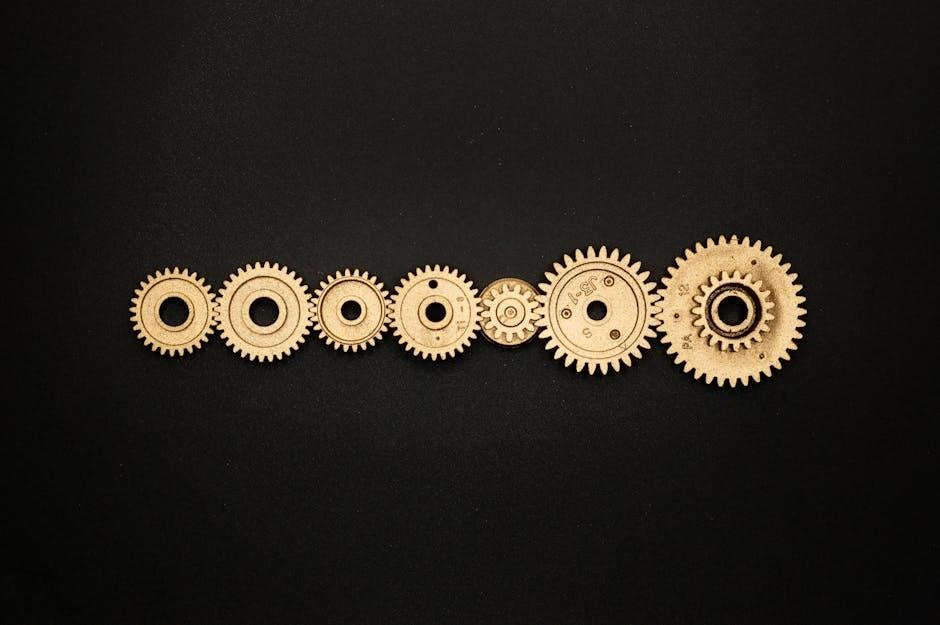
Technical Specifications of the 335i Manual Transmission
The BMW 335i manual transmission is a ZF S6-53 6-speed unit‚ designed for longitudinal engines‚ with a torque capacity of up to 443 lb-ft‚ ensuring robust performance.
Transmission Type and Design
The BMW 335i manual transmission is a ZF S6-53 6-speed longitudinal gearbox‚ known for its durability and smooth operation. Designed by ZF Friedrichshafen AG‚ it features a compact and lightweight construction‚ reducing overall vehicle weight while enhancing driving dynamics. The transmission is engineered to handle up to 443 lb-ft of torque‚ making it suitable for the 335i’s powerful inline-6 engine. Its internal components‚ including gears and bearings‚ are optimized for both performance and efficiency. The S6-53 is also equipped with a low-friction design‚ contributing to better fuel economy and a more engaging driving experience. This transmission is a key component in delivering the 335i’s renowned balance of power and precision.
Torque Capacity and Performance Limits
The BMW 335i manual transmission‚ specifically the ZF S6-53‚ is designed to handle up to 443 lb-ft of torque‚ making it well-suited for the car’s powerful inline-6 engine. This gearbox is known for its robust construction and is used in various high-performance applications‚ including Ford and GM’s heavy-duty vehicles; While the stock transmission is reliable for everyday driving and moderate performance‚ it can struggle with excessive power‚ especially in modified engines. For instance‚ clutch slippage may occur at around 400wtq‚ requiring upgrades such as a performance clutch and flywheel. However‚ the transmission itself can reliably handle up to 500wtq with proper modifications‚ ensuring it remains a capable choice for both stock and tuned 335i models.
Gear Ratios and Shifting Mechanism
The BMW 335i manual transmission features a 6-speed gearbox with well-spaced gear ratios optimized for both performance and efficiency. The ZF S6-53 transmission offers smooth‚ precise shifting‚ enhancing driver engagement. Its lightweight‚ compact design and low-friction components improve driving enjoyment and fuel efficiency. The gear ratios are tailored to deliver strong acceleration in lower gears while maintaining comfortable cruising speeds on the highway. The manual transmission’s shifting mechanism is renowned for its ease of use and direct feel‚ making it a favorite among enthusiasts. This setup ensures a responsive and involving driving experience‚ perfectly complementing the 335i’s sporty character.

Performance and Capabilities with the Manual Transmission
The BMW 335i manual transmission delivers exceptional acceleration and precise control‚ enabling a 0-60 mph sprint in just 4.9 seconds. It enhances driver engagement and responsiveness‚ making it a thrilling choice for enthusiasts.
Acceleration and Power Delivery
The BMW 335i with a manual transmission excels in acceleration‚ achieving a 0-60 mph time of around 4.9 seconds. The 6-speed manual gearbox optimizes power delivery from the 3.0-liter inline-6 engine‚ which produces 306 horsepower and 295 lb-ft of torque. The precise control over gear shifts allows drivers to fully exploit the engine’s power band‚ delivering a responsive and exhilarating driving experience. This setup is particularly advantageous in dynamic driving scenarios‚ where quick and deliberate shifts enhance both performance and driver engagement. The manual transmission’s direct connection to the engine makes it a preferred choice for enthusiasts seeking a more immersive and sporty feel behind the wheel.
Handling and Driver Engagement
The BMW 335i with a manual transmission delivers exceptional handling and driver engagement‚ thanks to its precise and tactile shifting mechanism. The direct mechanical connection between the driver and the car enhances responsiveness‚ allowing for intuitive control during cornering and acceleration. Rear-wheel drive and near-perfect weight distribution further amplify the car’s agility‚ making it a joy to navigate twisty roads. The manual gearbox encourages active participation‚ with each gear shift feeling deliberate and satisfying. This level of engagement creates a deeper connection between the driver and the vehicle‚ elevating the overall driving experience and making the 335i a standout choice for enthusiasts who value driving dynamics and precision.
Comparison with Automatic and DCT Transmissions
The BMW 335i manual transmission offers distinct advantages over its automatic and DCT counterparts. While automatics prioritize convenience and DCTs focus on rapid shifting‚ the manual gearbox provides a more engaging and driver-centric experience. It allows for full control over gear changes‚ enhancing connection to the vehicle. The manual is lighter and more mechanically efficient‚ contributing to better fuel economy and lower maintenance costs. In contrast‚ DCTs‚ though faster-shifting‚ can feel less smooth in low-speed driving and are more complex. Automatics‚ while smooth‚ lack the tactile feedback of a manual. Thus‚ the manual transmission remains the preferred choice for purists seeking a more immersive driving experience.
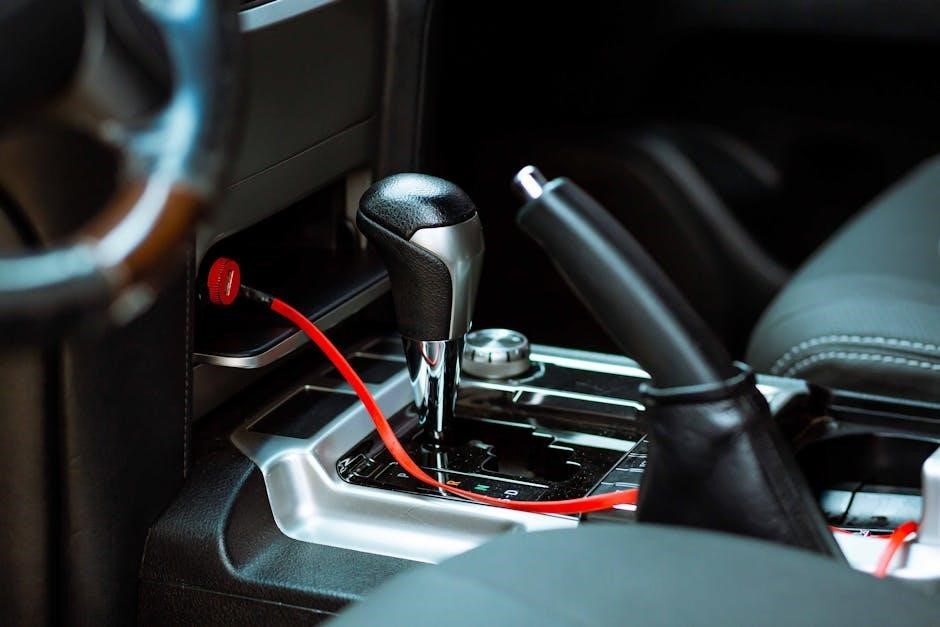
Cost and Maintenance of the 335i Manual Transmission
The 335i manual transmission swap can cost around $3‚848‚ with remanufactured units available. Maintenance involves regular transmission fluid changes and potential clutch replacements‚ with labor costs varying by location and expertise.
Estimated Cost of Manual Transmission Swaps
The estimated cost of a manual transmission swap for the BMW 335i can range significantly‚ depending on the source and condition of the parts. A remanufactured 6-speed manual transmission typically costs around $2‚800‚ with free shipping‚ while a used transmission may be slightly cheaper. Labor costs for the swap can add another $1‚000 to $1‚500‚ depending on the mechanic’s expertise and location. For a complete swap‚ including the transmission‚ clutch‚ flywheel‚ and other necessary components‚ the total cost can range from $5‚000 to $7‚000. Additionally‚ factors such as the seller‚ warranty‚ and any custom modifications can influence the final price.
Maintenance and Repair Expenses
Maintenance and repair expenses for the BMW 335i manual transmission are moderate‚ with routine service essential to ensure longevity. Transmission fluid changes are recommended every 30‚000 to 60‚000 miles‚ costing around $200 to $300. Clutch replacements‚ which may be needed every 50‚000 to 100‚000 miles depending on driving habits‚ can range from $1‚000 to $1‚500. Synchronizer repairs‚ if necessary‚ add another $500 to $1‚000. Regular inspections and timely repairs help prevent major issues‚ keeping overall costs manageable. Proper maintenance ensures smooth operation and sustains the transmission’s performance over time‚ making it a cost-effective option for enthusiasts who value a hands-on driving experience.
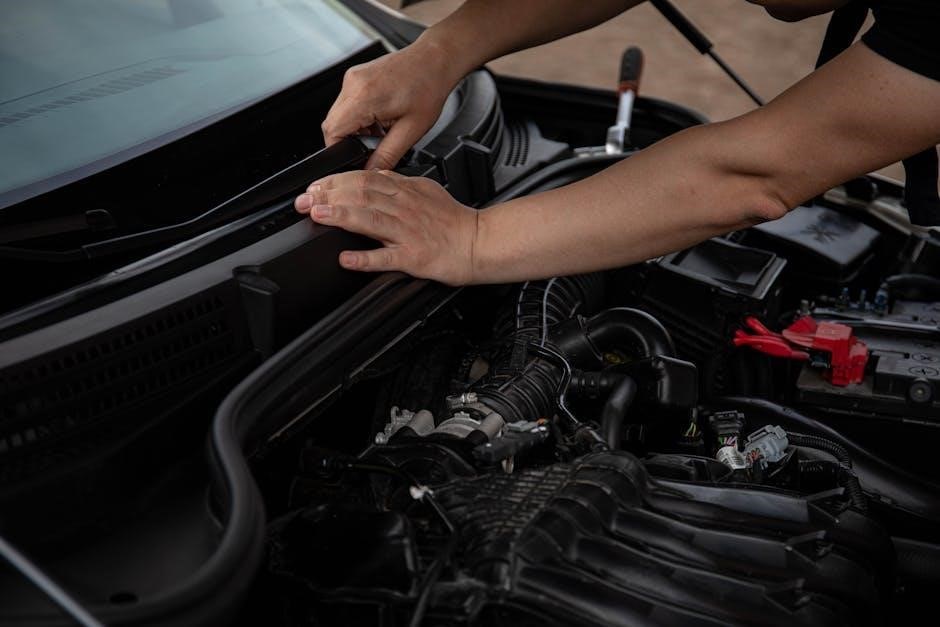
Rebuild and Replacement Options
Rebuilding or replacing the BMW 335i manual transmission offers several options. A transmission rebuild kit‚ available from BMW‚ includes necessary components like bearings‚ seals‚ and gaskets‚ costing around $1‚200. For more severe damage‚ a complete replacement transmission can be sourced‚ with remanufactured units priced between $2‚500 and $4‚000. Used transmissions are also available‚ though condition and mileage vary. Third-party suppliers offer aftermarket components‚ such as upgraded clutches and gears‚ for enhanced performance. Professional installation is recommended for both rebuilds and replacements to ensure reliability and maintain warranty validity. These options provide flexibility for owners seeking to restore or upgrade their manual transmission‚ ensuring optimal performance and longevity.
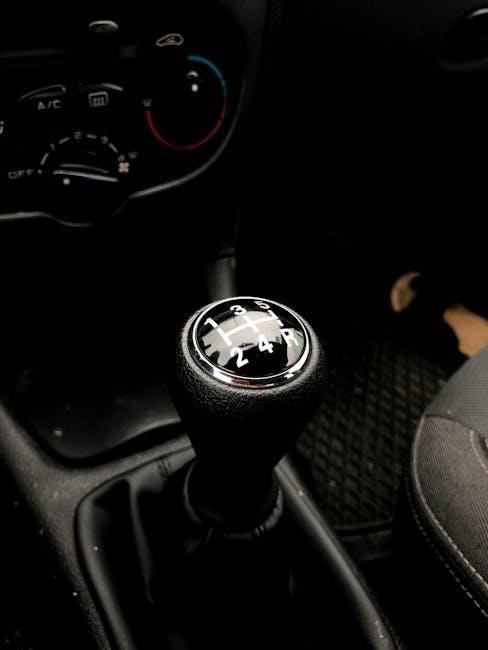
Reliability and Common Issues
The BMW 335i manual transmission is generally reliable but can experience issues like clutch slippage‚ synchronizer wear‚ and transmission fluid leaks. Regular maintenance is essential.
Known Problems with the 335i Manual Transmission
The BMW 335i manual transmission‚ while robust‚ can experience issues such as clutch slippage under high torque and synchronizer wear‚ leading to poor shifting. Transmission fluid leaks and premature wear of bearings are also reported. These problems often stem from aggressive driving or high-mileage use. Regular maintenance is critical to avoid costly repairs. Drivers have noted that clutch slippage becomes noticeable when torque exceeds 550-600 lb-ft‚ requiring upgrades. Synchronizer wear can cause grinding or hesitation between gears‚ particularly in higher miles. Addressing these issues early is essential to maintain the transmission’s performance and reliability over time. Proper care and timely repairs can extend its lifespan significantly.
Clutch and Synchronizer Wear
Clutch and synchronizer wear are common issues in the BMW 335i manual transmission‚ particularly under high-performance driving conditions. The clutch may slip when torque exceeds 500-550 lb-ft‚ requiring upgrades. Synchronizer wear leads to grinding or hesitation between gears‚ especially in higher-mileage vehicles. These problems often result from aggressive shifting or excessive wear over time. Replacing the clutch and synchronizers can be costly‚ so regular inspection and maintenance are crucial. Upgrading to a performance clutch and flywheel can help mitigate these issues‚ ensuring smoother shifting and enhanced durability. Addressing wear early prevents further damage and maintains optimal transmission performance. Proper driving techniques and timely repairs are essential to extending the lifespan of these components.
Transmission Fluid and Service Intervals
Regular maintenance of the BMW 335i manual transmission involves checking and replacing the transmission fluid to ensure optimal performance and longevity. The recommended fluid type is typically a synthetic gear oil‚ such as the ZF-approved specification‚ designed to lubricate and protect the gears and bearings. Service intervals for the transmission fluid vary depending on driving conditions‚ with recommendations ranging from 30‚000 to 60‚000 miles for normal use and more frequent changes for high-performance or track-driven vehicles. Neglecting fluid changes can lead to degraded lubrication‚ increased wear on synchronizers and gears‚ and potential premature failure. Timely service is crucial to maintain the transmission’s smooth operation and extend its lifespan. Always consult the manufacturer’s guidelines for specific recommendations.
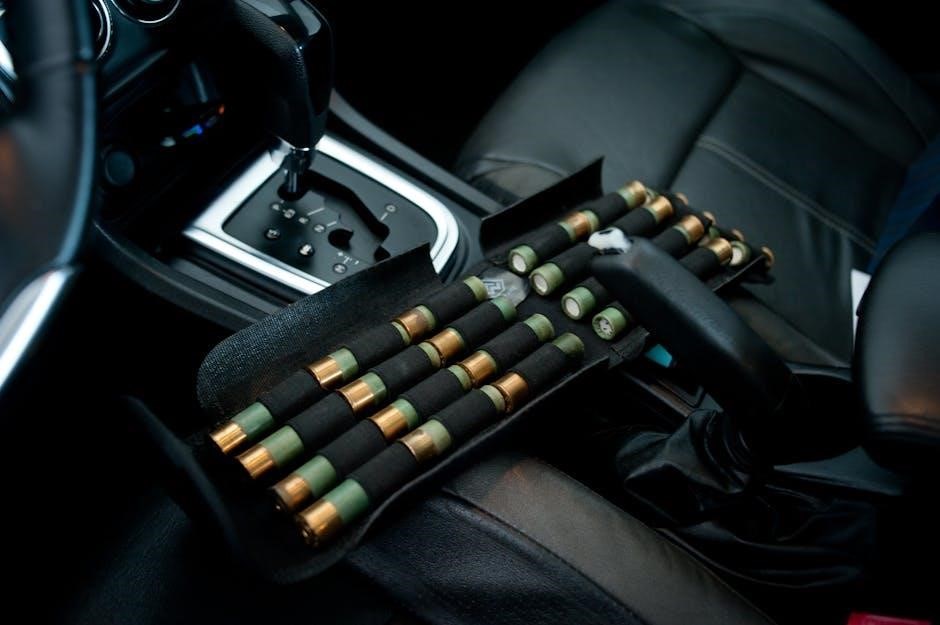
Upgrades and Modifications
Enthusiasts often enhance the 335i manual transmission with performance upgrades‚ including lightweight flywheels‚ high-capacity clutches‚ and reinforced gearsets‚ to handle increased power and torque outputs.
Performance Upgrades for the Manual Transmission
Upgrading the manual transmission in the BMW 335i can significantly enhance its performance capabilities. One popular modification is the installation of a lightweight flywheel and a high-performance clutch‚ which reduces inertia and improves power delivery during shifts. Additionally‚ enthusiasts often opt for reinforced gearsets to handle increased torque‚ especially in modified engines. Another common upgrade is the addition of a short-shifter kit‚ which reduces shift throw and makes gear changes quicker and more precise. These upgrades not only improve the driving experience but also ensure the transmission can withstand higher power outputs‚ making them essential for track-driven or heavily tuned vehicles.
Clutch and Flywheel Upgrades
Upgrading the clutch and flywheel in the BMW 335i is crucial for enthusiasts seeking enhanced performance‚ especially when increasing power output. The stock clutch can begin to slip under higher torque conditions‚ such as Stage 2 tunes producing around 400wtq. Replacing it with a high-performance clutch and lightweight flywheel improves power delivery and reduces inertia‚ allowing for quicker and smoother shifts. Popular options include Sachs or Clutch Masters kits‚ designed to handle increased torque while maintaining drivability. These upgrades are particularly beneficial for track use or heavily modified engines‚ ensuring reliability and preventing premature wear. They also complement other transmission upgrades‚ making them a priority for performance-driven owners.
Aftermarket Transmission Components
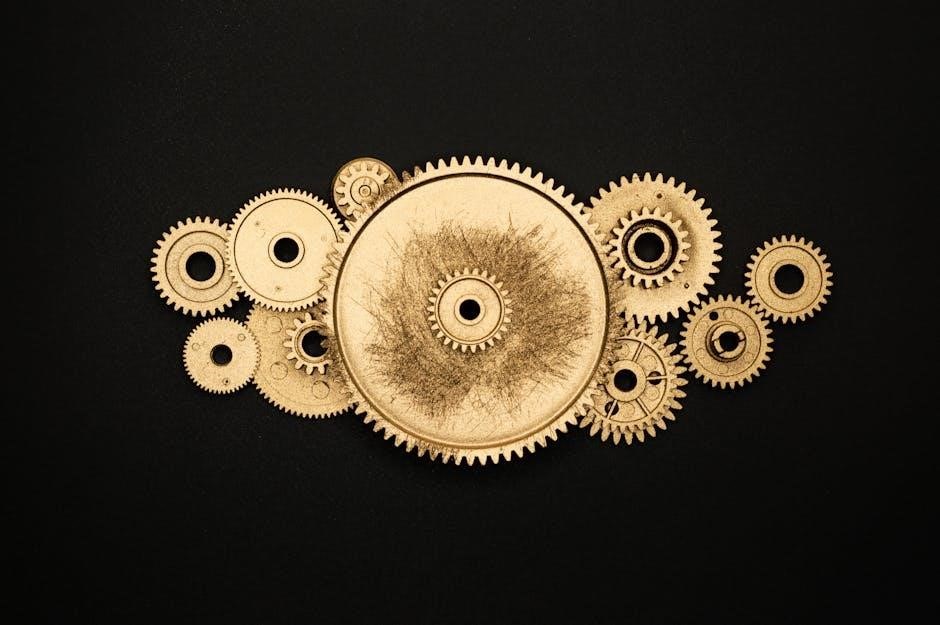
Aftermarket transmission components for the BMW 335i manual transmission offer enhanced durability and performance for spirited driving. Upgraded parts like reinforced mounts‚ lightweight flywheels‚ and high-strength gear sets are popular among enthusiasts. Companies such as Quaife provide limited-slip differentials for improved traction‚ while others offer transmission braces to reduce flex under hard acceleration. These components are designed to handle increased power from tuned engines‚ ensuring smoother gear engagement and stability. They are particularly beneficial for track use or aggressive driving‚ where stock parts may falter. Aftermarket options also include shorter shift throw kits for quicker gear changes‚ further enhancing the driving experience. These upgrades allow owners to maximize their car’s potential while maintaining reliability and performance.

Driver Reviews and Feedback
Drivers praise the BMW 335i manual transmission for its smooth‚ precise shifting and engaging driving experience. Enthusiasts highlight its forgiving nature‚ making it accessible for both novice and experienced drivers alike.
Owner Experiences with the 335i Manual Transmission
Owners of the BMW 335i with a manual transmission consistently praise its smooth and precise shifting‚ which enhances the driving experience. Many enthusiasts appreciate the connection it provides‚ making the car feel more responsive and enjoyable. Some owners have noted that the manual transmission is forgiving‚ especially for those transitioning from automatics or less refined manual vehicles. However‚ a few have reported issues such as clutch wear and synchronizer problems‚ particularly with higher mileage or aggressive driving. Regular maintenance and proper driving techniques are often emphasized to prolong the transmission’s longevity and performance. Overall‚ the manual transmission in the 335i is celebrated for its balance of sportiness and everyday usability.
Comparison with Other BMW Manual Transmissions
The BMW 335i’s 6-speed manual transmission is often compared to other BMW manual transmissions‚ such as the ZF S6-53 used in the M3. While the M3’s transmission is more performance-oriented‚ the 335i’s gearbox offers a balance of sportiness and everyday usability. The 335i’s manual transmission is praised for its smooth and precise shifting‚ often described as more refined than older BMW manual transmissions. It also features a lightweight and compact design‚ which enhances fuel efficiency and driving dynamics. With a torque capacity of up to 443 lb-ft‚ it is well-suited for the N54 and N55 engines‚ making it a popular choice for tuning and modifications. Overall‚ the 335i’s manual transmission stands out for its versatility and driver engagement.
Pros and Cons of the Manual Transmission
The BMW 335i’s manual transmission offers a more engaging and precise driving experience‚ with smooth‚ well-defined gear shifts that enhance driver connection to the road. It is praised for its lightweight design‚ optimal gear ratios‚ and fuel efficiency. However‚ it may lack the convenience of an automatic‚ particularly in heavy traffic. While it is generally reliable‚ issues like clutch wear and synchronizer problems can arise‚ especially under heavy use. The manual transmission also requires more maintenance‚ such as regular transmission fluid changes. Despite these drawbacks‚ many enthusiasts prefer the manual for its sporty feel and responsiveness‚ making it a worthwhile choice for those who value driving involvement.
The BMW 335i manual transmission delivers a sporty‚ engaging drive with precise shifts‚ making it ideal for enthusiasts. However‚ it requires regular maintenance and may experience wear over time.
Final Thoughts on the BMW 335i Manual Transmission
The BMW 335i manual transmission stands out as a refined and engaging option for driving enthusiasts. It offers precise control and a sporty feel‚ enhancing the overall driving experience. While it may require more attention and maintenance compared to automatic counterparts‚ the connection it provides to the vehicle makes it a worthwhile choice. Owners often praise its durability‚ though common issues like synchronizer wear and clutch slippage under high torque should be monitored. Upgrades and proper maintenance can extend its lifespan‚ ensuring continued performance and satisfaction for years to come.
Is the Manual Transmission Worth It for the 335i?
The manual transmission in the BMW 335i is a compelling choice for driving enthusiasts seeking a more engaging experience. It offers precise control‚ enhancing acceleration and connection to the road‚ ideal for spirited or track driving. While it may require more attention and maintenance‚ such as monitoring for synchronizer wear and clutch slippage under high torque‚ the benefits of a more connected drive can outweigh these costs for many. Additionally‚ manual transmissions can be a selling point for future resale‚ particularly among enthusiasts. For those prioritizing a dynamic driving experience‚ the manual transmission is a worthwhile consideration‚ especially with available upgrades to enhance performance and reliability. Balancing the pros and cons based on driving habits and budget will help determine if it suits your lifestyle. Ultimately‚ the manual transmission in the 335i is a great option for those who value an engaging drive and are willing to manage the associated upkeep.
